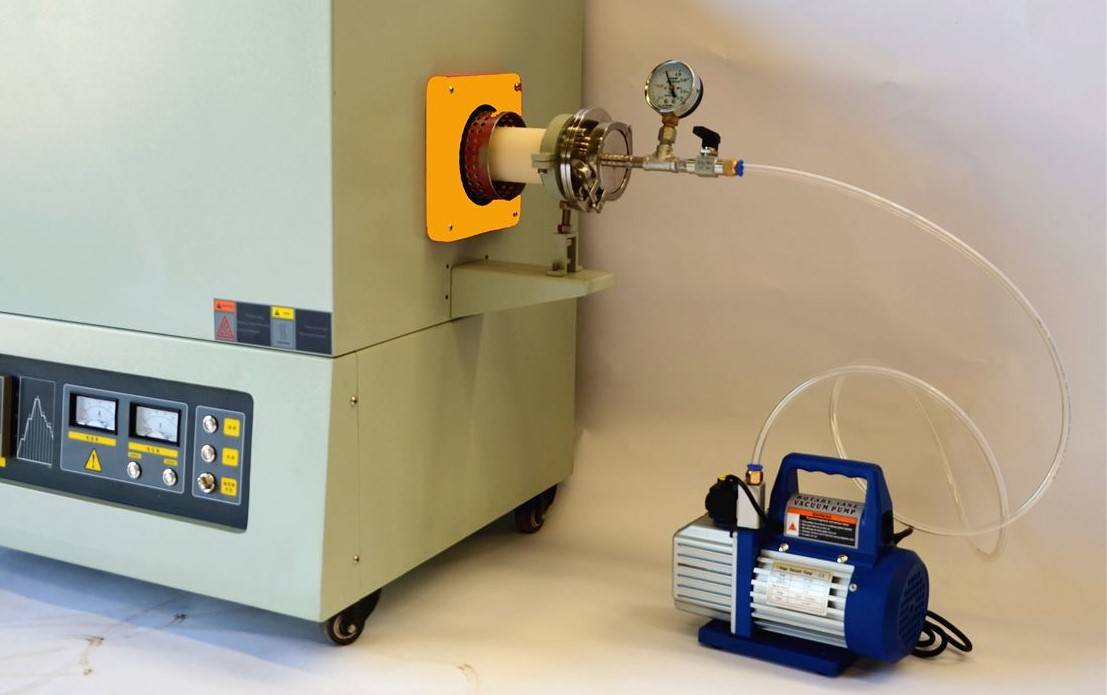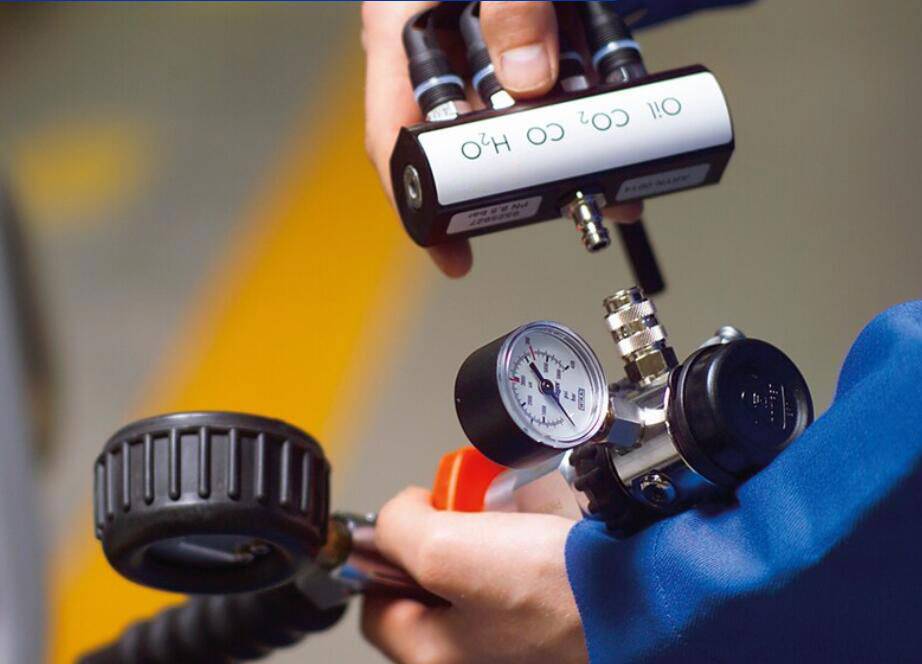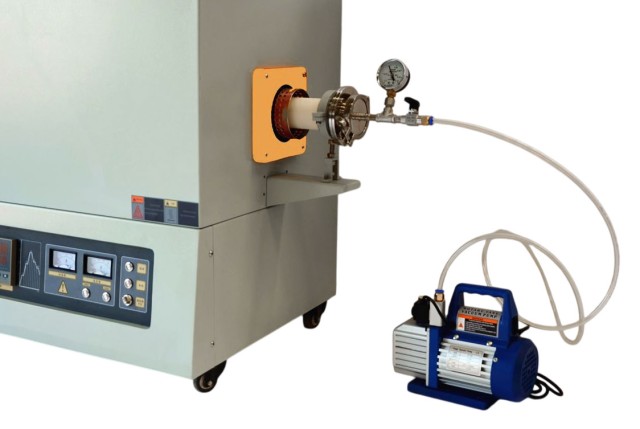Initial Setup and Vacuum Pumping
Closing Gas Lines and Connecting to Vacuum Pump
To begin the transition from gas operation to vacuum pumping, the first critical step is to close the working gas line. This ensures that no additional gas enters the system, maintaining a controlled environment within the tube furnace. Once the gas line is securely closed, the next action is to connect the tube furnace gas outlet end to the vacuum pump. This connection is crucial as it sets the stage for the next phase of the process, which involves evacuating the tube body and gas piping to create the necessary vacuum conditions.
This initial setup is fundamental as it directly impacts the efficiency and effectiveness of the subsequent vacuum pumping operations. Properly closing the gas lines prevents any unintended gas flow, which could compromise the vacuum integrity. Meanwhile, the connection to the vacuum pump ensures that the system is ready to be evacuated, setting the stage for the precise control of gas pressure and flow in the later stages of the operation.
In summary, these preparatory steps are essential for ensuring that the vacuum tube furnace operates safely and efficiently under vacuum conditions, laying the groundwork for the successful execution of the sintering process.
Activating Vacuum Pump
To initiate the vacuum pumping process, begin by powering on the vacuum pump. This is a critical step to ensure that the system is ready to evacuate the tube body and gas piping effectively. Once the pump is operational, proceed to open the outlet valve. This action allows the pump to start drawing air out of the system, creating the necessary vacuum conditions.
During this phase, it is essential to monitor the vacuum gauge closely. The goal is to achieve a reading of -0.1 on the gauge, which indicates a successful evacuation of the tube body and gas piping. If the gauge does not reach this level, it may be necessary to check for any obstructions or leaks in the system.

Additionally, the evacuation process should be repeated multiple times to ensure that all residual gases are removed. This multi-step evacuation helps in achieving a more thorough vacuum, which is crucial for the subsequent sintering process. By following these steps, you can ensure that the vacuum tube furnace is properly prepared for the next stages of operation.
Checking Furnace Sealing
To ensure the integrity of the vacuum within the tube furnace, it is crucial to verify the sealing after the vacuum gauge reads -0.1. Here’s a detailed procedure to check the furnace sealing:
-
Close the Inlet Valve: Once the vacuum gauge indicates -0.1, immediately close the inlet valve to isolate the furnace from any external air sources.
-
Wait for One Hour: Allow the system to stabilize for an hour. During this period, monitor the vacuum gauge closely.
-
Assess the Vacuum Level: If the gauge maintains its reading at -0.1, it confirms that the sealing is effective, and there are no leaks. However, if the gauge reading drops, it indicates a leakage point.
-
Locate and Correct Leaks: In the event of a drop in vacuum level, use appropriate leak detection methods to identify the source of the leak. Common techniques include using a helium leak detector or applying soapy water to potential leak points. Once identified, correct the leak by tightening connections or replacing faulty components.
This procedure ensures that the furnace operates under optimal vacuum conditions, which are essential for successful sintering processes.
Gas Pressure Adjustment and Testing
Opening Gas Cylinder and Reducing Valve
To begin the process of gas pressure adjustment, first, locate the gas cylinder and identify the main valve. Turn the knob clockwise to open the main valve of the gas cylinder. This action allows the gas to flow from the cylinder into the system.
Next, focus on the outlet pressure reducing valve. Slowly turn the knob of the pressure reducing valve to open it gradually. This step is crucial to prevent sudden pressure surges that could damage the system. As you open the valve, monitor the outlet air pressure using the appropriate gauge. Maintain a reasonable outlet air pressure, typically aiming for a pressure below 0.05MPa, as specified in the operational guidelines.
By following these steps, you ensure a controlled and safe introduction of gas into the vacuum tube furnace system, setting the stage for subsequent adjustments and testing.

Adjusting Tube Furnace Inlet Valve
When adjusting the tube furnace inlet valve, it is crucial to proceed with caution to maintain optimal operating conditions. Begin by slowly opening the valve while closely monitoring the air pressure gauge. The objective is to keep the pressure below 0.05MPa, which is a critical threshold to prevent any undue stress on the system.
To achieve this, follow these steps:
-
Initiate Valve Opening: Gradually turn the inlet valve to allow gas flow into the furnace. This slow process ensures that the pressure does not spike abruptly.
-
Monitor Pressure Gauge: Continuously observe the air pressure gauge. The gauge should display a pressure reading that remains consistently below 0.05MPa. If the pressure starts to rise above this limit, immediately halt the valve opening process.
-
Adjust as Needed: If the pressure is approaching the 0.05MPa mark, slightly close the valve to reduce the flow rate. This fine-tuning helps in maintaining a stable and safe operating pressure.
By adhering to these steps, you ensure that the tube furnace operates within safe parameters, preventing potential damage or hazardous conditions.
Vacuum Pumping and Gas Flow
After stabilizing the air pressure, the next step involves meticulous vacuum pumping to ensure the system reaches the desired vacuum level. Initially, the inlet valve is closed to isolate the system, followed by the opening of the outlet valve to initiate the vacuum process. The goal is to achieve a vacuum of -0.1, a critical threshold for many high-vacuum applications. Once this level is reached, the outlet valve is closed to maintain the vacuum. This process is repeated three times to ensure thorough evacuation and to minimize any residual gas molecules within the system.
The repetition of this process is essential due to the nature of gas flow under different vacuum conditions. At high pressures, gas flow is typically viscous, where gas molecules collide frequently with each other. As the vacuum increases, the flow transitions from viscous to molecular, characterized by gas molecules traveling longer distances without collisions. This transition is crucial for effective vacuum pumping, as it shifts the mode of gas evacuation from pressure-driven to molecular-driven.
In high-vacuum systems, it is common to use a combination of pumps to handle different flow regimes. Positive displacement pumps are effective in viscous flow conditions, but as the system approaches molecular flow, momentum transfer or entrapment pumps become necessary. These pumps are designed to handle the random movement of gas molecules, ensuring that the system can maintain a high vacuum without stalling or requiring frequent regeneration.
The use of multiple pumps in tandem is a standard practice in high-vacuum systems. Positive displacement pumps start the evacuation process, but as the vacuum deepens, momentum transfer pumps take over. This dual-pump setup ensures that the system can handle the transition from viscous to molecular flow efficiently, maintaining a consistent and high-quality vacuum.
Final Adjustments and Heating Initiation
Setting Up Gas Flow
To ensure proper gas flow during the sintering process, begin by opening the tube furnace inlet valve. This initial step allows gas to enter the system, setting the stage for subsequent adjustments.
Next, carefully adjust the outlet valve. The goal is to achieve a consistent gas bubble speed of 2 bubbles per second in the conical flask. This precise control ensures that the gas flow is neither too rapid nor too slow, maintaining optimal conditions for the sintering process.
It is crucial to ensure that the gas is safely discharged. This can be done either outdoors or into an exhaust cabinet. Proper ventilation prevents any hazardous buildup and maintains a safe working environment.
Pre-Heating Procedure
Before initiating the heating process, it is crucial to aerate the system thoroughly. This preliminary step ensures that any residual gases or impurities are effectively removed, thereby optimizing the environment within the vacuum tube furnace for the sintering process.
To accomplish this, the system should be aerated for a minimum of ten minutes. During this period, the gas flow should be maintained at a steady rate, typically set to achieve a gas bubble speed of 2 bubbles per second in the conical flask. This controlled aeration helps in uniformly distributing the sintering gas throughout the furnace, ensuring that the internal atmosphere is consistent and conducive to the desired sintering outcomes.
Additionally, it is important to ensure that the gas is being discharged either outdoors or into an exhaust cabinet to prevent any potential exposure to harmful gases. This safety measure is integral to maintaining a secure working environment and protecting both the operators and the surrounding facilities.
Related Products
- Vertical Laboratory Quartz Tube Furnace Tubular Furnace
- Vacuum Hot Press Furnace Heated Vacuum Press Machine Tube Furnace
- Customer Made Versatile CVD Tube Furnace Chemical Vapor Deposition Chamber System Equipment
- 1400℃ Laboratory Quartz Tube Furnace with Alumina Tube Tubular Furnace
- High Pressure Laboratory Vacuum Tube Furnace Quartz Tubular Furnace


























